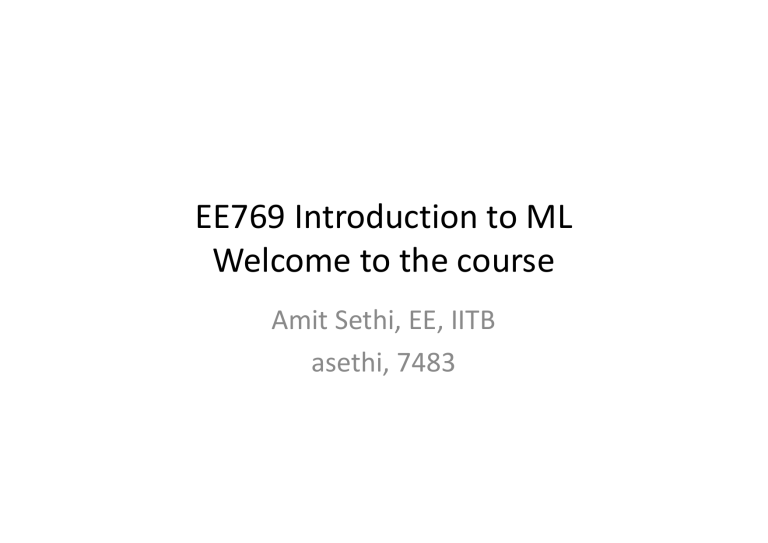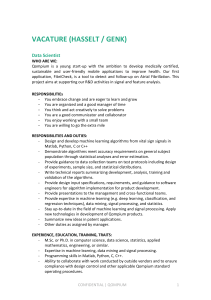
EE769 Introduction to ML Welcome to the course Amit Sethi, EE, IITB asethi, 7483 Instructor Introduction Employment: Current: IIT Bombay Previous: IIT Guwahati, ZS Associates, Chicago NEC Labs, Cupertino Research: Computational pathology, medical image analysis Deep learning, machine learning, Image processing, signal processing Education: IIT Delhi, B Tech in EE UIUC, PhD in ECE 2 Sample research Sample research Why make machines learn? Inputi Models Outputi • We need models (functions, algorithms) to make predictions about inputs • Many models are unknown and difficult to define • Machine learning is the art and science of iteratively adjusting models based on inputs and some properties of the output Some recent success stories Automatic vehicle navigation • Road recognition • Automatic navigation Speech recognition • Speech to text • Automated services over the phone Face detection • Facebook face tagging suggestions • Camera autofocus for portraits 6 ML gives a model • Elements of a model: • Input xi • Function fθ(xi) • The model has to be useful: • Some notion of ideal output yi • Loss L(yi, fθ(xi), θ) Good examples of ML problems • • • • • • • • • Is a given face image of a male or female? Is there a Coke bottle in a given image? Is this image artistic? How can this text be improved or question answered? Is this customer likely to spend more later if we give her a discount now? Can I represent a 50-d data using 2-d? Can I divide my customers into logical groups? Can I generate music that sounds like Mozart? Inverse problem: source separation, superresolution Bad examples of ML problems • • • • Predict the next lunar eclipse Understand this text Analyze this MRI scan Go through customer reciepts at a general store to predict who should be given a targeted discount A simplified view of ML Input x Model Hyper-parameters Parameters Desired output y Learning algorithm Output f(x) Loss function (and regularization) Supervised Machine Learning System - Training Components of a Trained ML System Supervised Machine Learning System - Testing Input x Model Hyper-parameters Parameters Output f(x) Performance criteria • • • • • • Accuracy Risk Explanability Memory Training time Testing time Requirements • Good amount of data • Clean and organized data • Computational power Course objectives • Define machine learning and cast ML problems • Define and code popular ML algorithms • Critique and compare ML algorithms and models 14 You will learn to • • • • • • • Assess whether a problem is suited for ML Map problems to popular ML frameworks Precisely define and describe ML models Code and train ML models Compare ML models and algorithms Follow basic proofs of guarantees in ML Identify directions for advanced ML R&D Prerequisites • Basic linear algebra – Matrix-vector products, dot products, eigen vector definition, norms, … • Intermediate probability – Continuous random variable, PDF, conditional distribution, marginalization • Basic calculus – Derivatives, partial derivatives, critical points of a function • Intermediate programming in python – Loops, functions, arrays, i/o, file i/o, graph plotting Topic plan • • • • • • • Linear regression Nonlinear regression Sparse models Linear classification Nonlinear classification Optimization Feature engineering • • • • • • • Intro to deep learning Combining models Dimension reduction Clustering Modeling densities EM algorithm Intro to learning theory Evaluation plan Item Wt. Min. marks Grade 90 AA 80 AB 70 BB 21 60 BC Mid-sem exam 18 50 CC End-sem exam 27 40 CD 30 DD/AU Class notes / tutorials / quizzes (10 to 12) 10 Programming assignments (3) 24 Project Total 100 Evaluation items • • • • • • • Precise understanding of concepts Express concepts mathematically Make basic mathematical derivations Program diligently Design experiments diligently Interpret results Zero tolerance for academic malpractice Allowed vs. not-allowed Allowed • Exams – Bring one sheet of notes • Assignments – Discuss the assignment before starting a portion with friends – Consult code on the internet – Disclosing sources of “inspiration,” indicating the exact lines copied Not allowed • Exam – Open the internet – Communicate with others • Assignments – Copy code from friend or internet and make trivial changes – Not disclosing sources of “inspiration” and the exact lines copied • Quizzes – Communicate with others How to get the most out of this course • • • • • • Attend lectures and take notes Read books and internet resources Attempt problems Discuss with classmates offline and online Become comfortable with programming Ask TAs and instructors any remaining doubts Resources • People: – Instructor: Amit Sethi, EE / CMINDS / KCDH, IITB (Chat on MS Teams, tag in channel) – TAs: TBD • Office hours (Wednesdays 6pm to 7pm): – Amit Sethi’s office, easternmost on second floor, EE building (7483) – MeDAL lab, first floor, EE building (4496) • LMS – MS Teams code w53to5d (Class channel for announcements and material, General channel for discussions and queries) – Moodle (course id 6149) for assignment submissions and grades • Books – Pattern Recognition and Machine Learning, by Christopher Bishop – Understanding Machine Learning: From Theory to Algorithms, by Shalev-Shwartz and Ben-David Emergency absence policy • Doctor’s note or documentation essential • Assignments: extension of deadline • Exams: Extrapolation of your performance based on your percentile (not percent) Resume verification • Sorry, I cannot verify resumes for such a large class • Make a GitHub Repo, and upload your assignment and project reports on ArXiv for the recruiters to see Ineligibility • First year and second year undergrads are not allowed • CSE, CS minor, and CMINDs minor should take similar courses meant for them, such as DD303 etc. • IEOR, ME, and CSRE students are requested to take equivalent courses in their departments • Any student who has done or is doing an equivalent (e.g. CS 419, 337, 725, 747, GNR 652, IE 506, 611, ME 781...) or advanced IITB/exchange univ course on ML (e.g. CS 726, 729, IE 643, 663, 712, GNR 638, ...) Immediate tasks • Python: – https://www.learnpython.org/ • Numpy and Google CoLab: (Basic python, numpy, pandas, matplotlib, scikit-learn) – https://cs231n.github.io/python-numpy-tutorial/ • Linear algebra and calculus: – https://stanford.edu/~shervine/teaching/cs-229/refresher-algebra-calculus • Probability: – https://stanford.edu/~shervine/teaching/cs-229/refresher-probabilities-statistics



